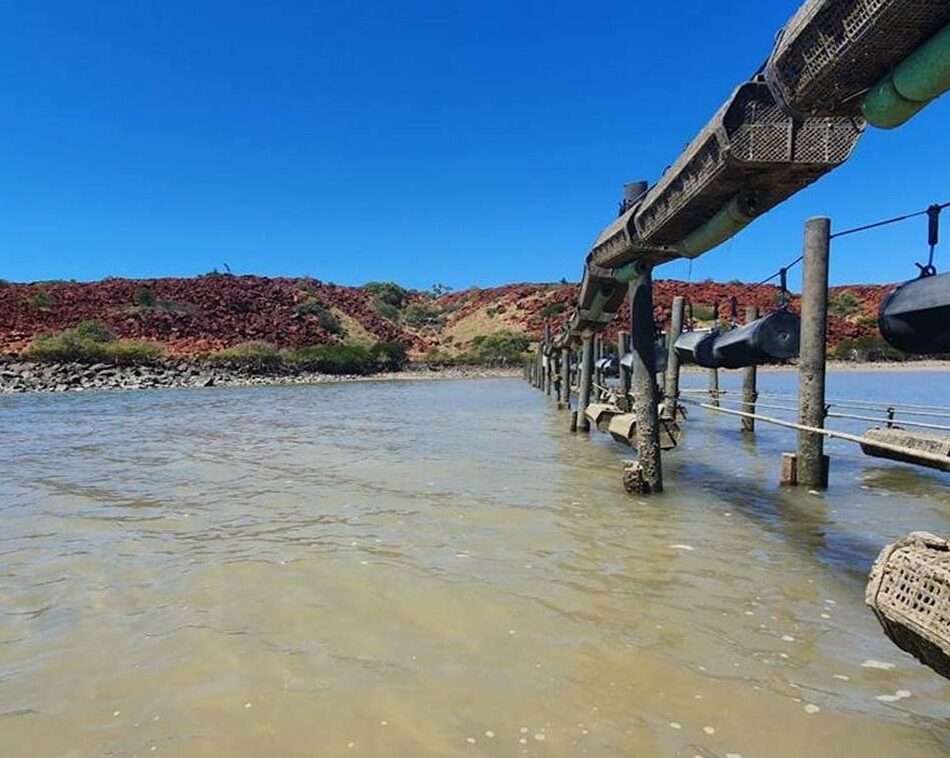A Cooperative Research Centre for Developing Northern Australia’s (CRCNA) aspirations to establish a commercial Tropical Rock Oyster industry in Northern Australia has taken a step forward today, with more than 30,000 hatchery-grown spat (juvenile oysters) transferred to new trial sites off the Karratha coast, in northern Western Australia.
Project partners, Maxima Rock Oyster Company (Maxima) successfully transferred the spat to grow-out baskets at two new Pilbara trial sites – West Lewis and Cossack this week.
The juveniles will grow to market size over the next 18 months with their progress being monitored by rangers from the Murujuga Aboriginal Corporation.
Today’s transfer follows the successful breeding of the Tropical Black Lip Rock Oysters by researchers from the Western Australian Department of Primary Industries and Regional Development’s (WA DPIRD) Hillary’s marine shellfish hatchery earlier this year.
The Northern Australia Tropical Rock Oyster project includes teams working in Western Australia and the Northern Territory and aims to investigate optimal methods for growing Black Lip Rock Oysters in tropical climates. The WA project builds on the knowledge gained from Maxima’s 2019 R & D trial at Flying Foam Passage.
CRCNA CEO Jed Matz said today’s events were a significant milestone for the $4.1 million project.
“With each milestone, the teams in WA and the NT are moving closer to developing the knowledge and skills required to create a commercially successful TRO industry in Northern Australia.
“This TRO project has been the largest funding commitment to date ($1.2 million) from the CRCNA. We see this investment as a great example of the vast opportunities which exist for aquacultural development in the north – particularly for Traditional Owner-led enterprises.”
Maxima Managing Director John Hutton said the encouraging results achieved through the original trial project, along with the significant positive stakeholder support, provided Maxima with the confidence to continue the research.
“Maxima aims to become a globally-competitive rock oyster producer that creates local jobs, provides diversity to regional economies, and enables meaningful employment and business opportunities for Traditional Owners, and Western Australia’s North West coast is proving to be the best place for this new industry,” Mr Hutton said.
“The successful transfer of spat to the new trial sites is a major milestone in the research and development, and I look forward to taste-testing the locally grown oysters in 18 months.”
As well as monitoring the grow-out trial, Maxima will provide training to Murujuga Rangers in aquaculture monitoring and management techniques.
“Creating a skilled workforce to support oyster farming on a commercial scale is also key to the success and growth of the industry and we see great potential for continued partnerships with the Murujuga Aboriginal Corporation. No-one knows this sea country better than them,” Mr Hutton said.
Murujuga Aboriginal Corporation Chairperson Vince Adams said : ” this is the next major milestone in the project which we’ve been a part of since it started in 2017.
“It has maintained momentum due to the dedicated project partners, in addition to its great potential and importance to our land and people.
“Oysters have been a part of our local environment and a source of food for thousands of years. This project is building a sustainable business from our land and sea country with potential to create new jobs and training opportunities for our members, and to provide a new platform for sharing our local knowledge and culture,” said Mr Adams.
The WA Tropical Rock Oyster Research and Development project is being led by the WA DPIRD, Maxima, Murujuga Aboriginal Corporation, the Albany multispecies shellfish hatchery and gear suppliers Hexcyl Systems, SEAPA and Zapco Aquaculture.


